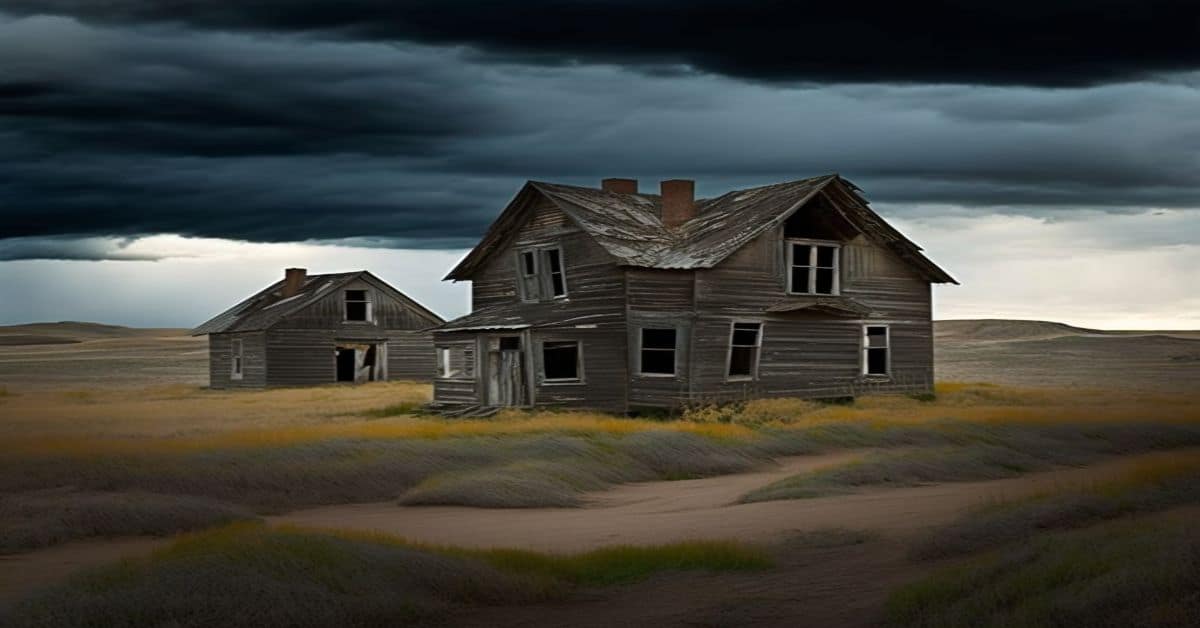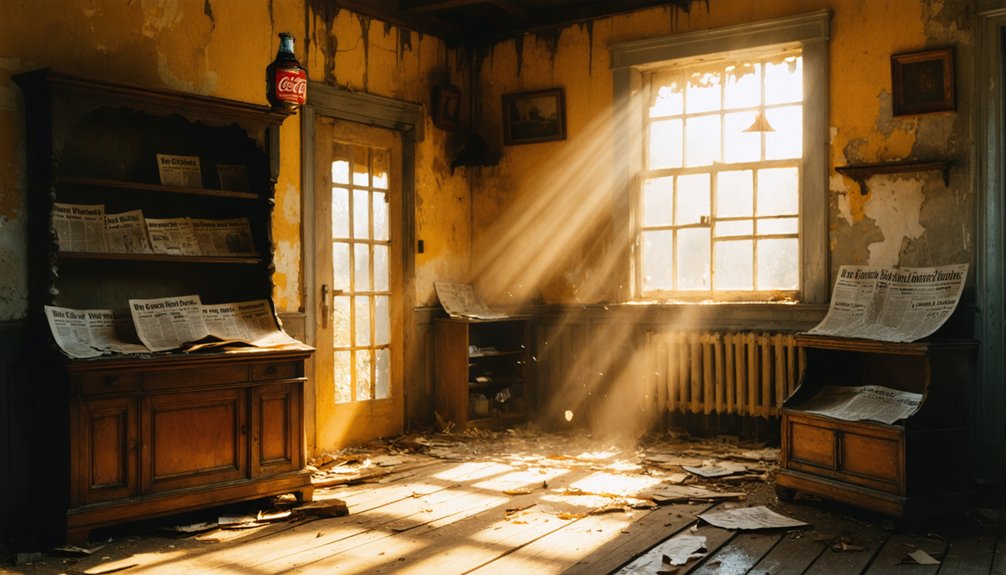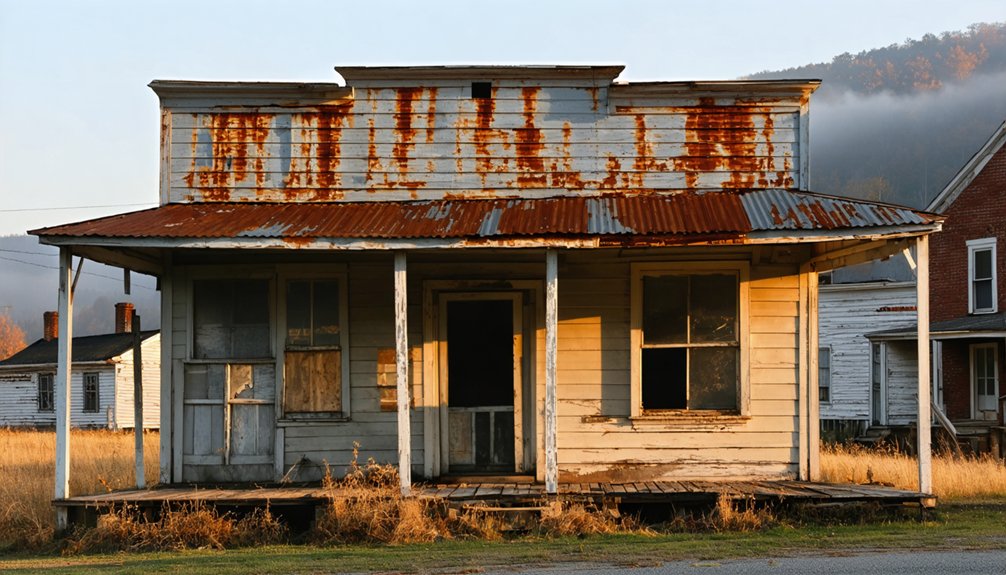Pleasant Hill’s Shaker community rose from humble beginnings in 1806 to become one of America’s most successful religious settlements. You’ll discover a once-thriving 4,500-acre commune that peaked at 600 members in the 1850s, known for its exceptional craftsmanship and agricultural innovation. While declining membership and financial troubles led to its abandonment by 1900, today you can explore 34 restored historic structures where tales of supernatural encounters add intrigue to this fascinating ghost town’s legacy.
Key Takeaways
- Pleasant Hill transformed from a thriving Shaker community of 600 members in the 1850s to just 34 residents by 1900.
- The settlement’s 4,500 acres and 260 buildings became largely abandoned following economic hardship and declining membership after the Civil War.
- Financial troubles, including a $14,000 debt by 1886, forced the community to sell assets and ultimately led to abandonment.
- Preservation efforts began in 1961, saving 34 historic structures that showcase the former Shaker settlement’s architectural heritage.
- The ghost town earned National Historic Landmark status in 1971 and features supernatural folklore within its restored buildings.
The Rise of a Shaker Settlement
When three Shaker missionaries commenced on a journey from Mount Lebanon, New York to Kentucky in 1805, they set in motion the establishment of what would become one of America’s most significant Shaker settlements. This location would later require clear distinction from other Pleasant Hill settlements across America.
You’ll find that their message resonated quickly, gaining converts like Elisha Thomas and the Banta brothers after a revival in Bourbon County. The community formalized in December 1806 with 44 covenant signers, initially settling on Thomas’ farm before relocating to Pleasant Hill in 1808.
The settlement’s strategic location near the Kentucky River fueled its rapid expansion. Under innovative community governance and distinctive Shaker architecture pioneered by Micajah Burnett, Pleasant Hill grew to house 491 members by 1823, eventually peaking at 600 residents in the 1850s with over 250 buildings across nearly 2,800 acres. The community’s dedication to agricultural innovation helped them develop 4,500 acres of land by 1823.
Daily Life and Religious Practices
At Pleasant Hill, daily life revolved around a carefully structured system of “families,” with 40-60 members living communally in separate dwellings.
You’d find married couples living as celibate Brothers and Sisters, while their children grew up in separate quarters until age 21. This unique arrangement fostered communal harmony through shared work, meals, and spiritual rituals.
The community’s distinctive worship practices earned them the name “Shakers,” as you’d witness members dancing, swaying, and speaking in tongues during services. They conducted these vibrant services in the central Meeting House. Today, visitors can still experience these traditional hymns and dances through music performances in the same historic building.
Two male and two female trustees led each family, reflecting the Shakers‘ commitment to gender equality. You’d see this egalitarian spirit in every aspect of daily life, from leadership roles to work assignments, creating a progressive society that championed racial equality and pacifism.
Economic Success and Trading Legacy
The Shakers’ spiritual dedication and communal lifestyle laid a strong foundation for their remarkable economic achievements. You’ll find their prowess reflected in Pleasant Hill’s rapid expansion to 4,500 acres and construction of over 260 buildings, demonstrating impressive economic sustainability.
They established extensive trade routes by 1816, shipping their high-quality goods via the Kentucky, Ohio, and Mississippi rivers to markets like New Orleans. Their diverse enterprises included premium livestock breeding, broom making, and manufacturing of patent medicines.
You’ll appreciate how their craftsmanship commanded prices about one-third higher than non-Shaker products. They weren’t just farmers – they operated one of America’s leading agricultural experimental stations and built Kentucky’s earliest municipal water systems, proving their innovative spirit and business acumen.
The Path to Abandonment
Despite their remarkable early success, Pleasant Hill’s path toward abandonment began during the Civil War years, when the community’s pacifist beliefs and disrupted trade routes strained their economic stability. Much like modern systems that require user verification to protect against threats, the community struggled to distinguish genuine members from opportunists.
You’ll find their declining membership was further complicated by leadership challenges and mounting debt that reached $14,000 by 1886. The once-thriving community couldn’t sustain itself as “Winter Shakers” drained resources without contributing meaningfully. The tragic death of respected member Abram Kulp in a horse-riding accident further demoralized the dwindling population.
- Membership plummeted from 491 in 1823 to just 34 by 1900
- Swedish immigrants’ arrival failed to offset the exodus of long-term members
- Rising apostasy weakened the community’s religious foundation
- Orphans rarely stayed beyond their required indentures
- Financial troubles and leadership vacuum accelerated the decline
Preserving History and Supernatural Tales
Since preservation efforts began in 1961, Pleasant Hill’s architectural and cultural legacy has found new life through meticulous restoration work and educational programs.
You’ll discover 34 historic structures that showcase the Shakers’ commitment to simplicity and utility, including the remarkable 1820 Meeting House and Trustee House with its rare twin spiral stairway.
While archaeological surveys and hands-on preservation projects document the tangible history, supernatural folklore adds another layer to Pleasant Hill’s story.
Beyond the carefully documented facts and artifacts lies a realm of spectral tales woven into Pleasant Hill’s enduring narrative.
The decades of abandonment have sparked tales of ghostly encounters within these carefully restored buildings.
Today, you can explore both the documented heritage through interpretive programs about Shaker craftsmanship and daily life, as well as the mysterious elements that have become part of the village’s allure as a preserved ghost town.
Located at 3501 Lexington Road, Pleasant Hill sits on a historic turnpike that played a strategic role during the Civil War era.
The local community’s commitment to preservation has intensified since the site earned its National Historic Landmark designation in 1971.
Frequently Asked Questions
Did Any Shakers at Pleasant Hill Ever Marry or Break Celibacy Rules?
You’ll be shocked to hear that, like today’s viral TikTok challenges, no documented Shaker marriage or celibacy breaches occurred at Pleasant Hill – they followed their strict rules without exception.
What Happened to Children Born to Converts Who Joined Pleasant Hill?
If your parents joined Pleasant Hill as converts, you’d be raised in the children’s orders, living separately from them. You’d receive education and learn trades until choosing to stay or leave.
How Did Pleasant Hill Shakers Handle Medical Care and Burial Practices?
You’ll find they managed healthcare through organized infirmaries, relying heavily on herbal remedies and trained caregivers. When death occurred, they emphasized communal responsibility, handling burials with characteristic Shaker simplicity and order.
Were African Americans Accepted as Equal Members in Pleasant Hill?
While 28 African Americans joined Pleasant Hill, you’ll find they faced integration challenges despite Shaker equality principles. Though accepted as members, community dynamics often placed them at society’s margins in social and visual contexts.
Did Pleasant Hill Shakers Maintain Contact With Family Members Outside the Community?
You’ll find limited evidence of ongoing communication methods with outside families. Once you joined, community bonds typically replaced traditional family dynamics, though some contact occurred during trade interactions.
References
- https://blog.shakervillageky.org/harrowing-history-halloween/
- https://www.cincinnatimagazine.com/article/curiosities-shakers/
- https://herlifeinruins.com/shaker-village-pleasant-hill/
- https://shakervillageky.org/history-and-restoration/
- https://archaeology.ky.gov/Find-a-Site/Pages/Pleasant-Hill-Shaker-Village.aspx
- https://en.wikipedia.org/wiki/Pleasant_Hill
- https://filsonhistorical.org/wp-content/uploads/publicationpdfs/14-3-3_Brief-History-of-the-Shaker-Colony-at-South-Union-Kentucky_Coombs-Elizabeth.pdf
- https://www.kentuckyhauntedhouses.com/real-haunt/shaker-village-pleasant-hill.html
- https://www.southernspiritguide.org/in-the-valley-of-love-and-delight-the-simple-spirits-of-pleasant-hill/
- https://www.nps.gov/places/shaker-village-at-pleasant-hill.htm



